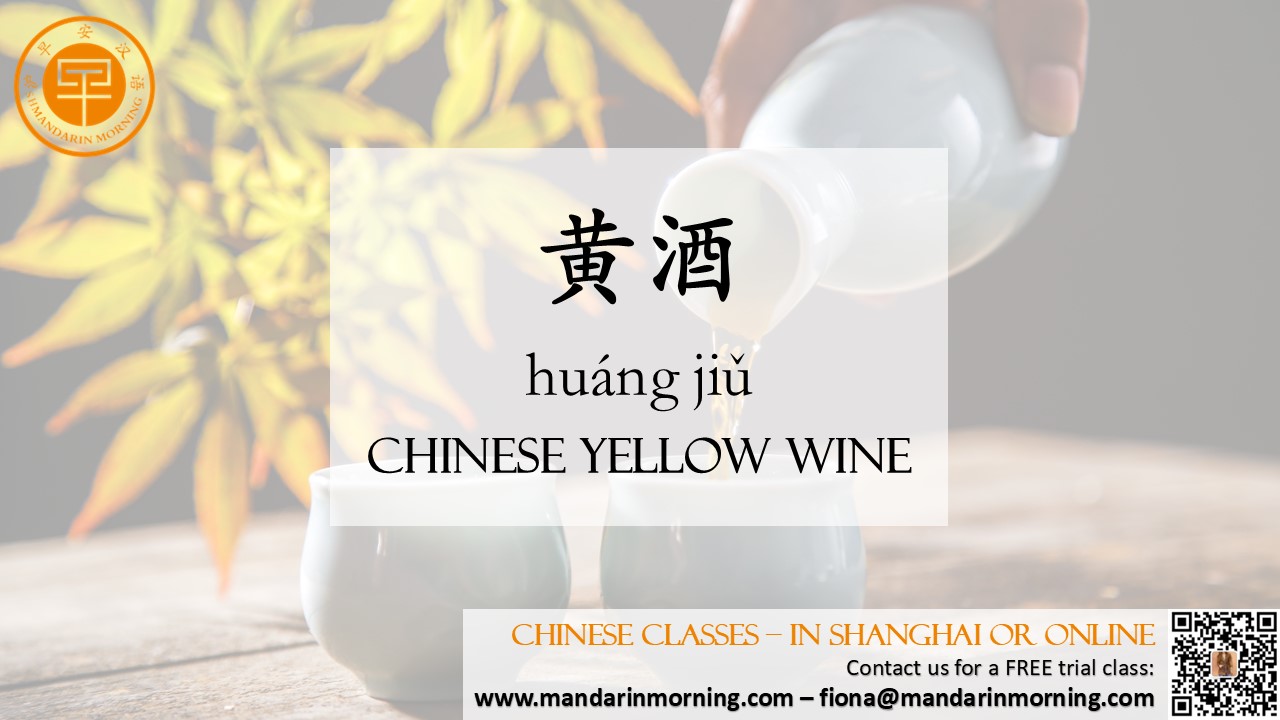| Huangjiu (黄酒; huáng jiǔ) is considered one of the most ancient wines, alongside beer (啤酒; pí jiǔ) and grape wine (葡萄酒; pú táo jiǔ). It holds a significant place in Chinese history and culture. When you read classic Chinese literature and encounter mentions of “wine” (酒; jiǔ), it is often referring to Huangjiu (黄酒). The wine is made from grains such as glutinous rice, millet, or wheat, and water. Its Chinese name 黄酒, literally “yellow wine,” comes from the amber hue it acquires during the brewing process. Huangjiu’s alcohol content is ranging from 8% to 20%. The wine holds a significant place in traditional Chinese medicine (TCM). It is not only appreciated as a beverage but also valued for its medicinal properties. Huangjiu is sometimes used as a solvent for herbal medicines to enhance their effects and aid in the delivery of medicinal properties throughout the body. A well-known example is the medicinal wine called “Danggui Huangjiu” (当归黄酒; dāngguī huángjiǔ), which combines Huangjiu with Angelica sinensis (当归; dāngguī) to promote blood circulation and treat menstrual disorders.  The Brewing Process Huangjiu’s unique flavor profile is achieved through a meticulous brewing process that has been refined over thousands of years. The process starts with steaming the grains to gelatinize the starches, making them more accessible for fermentation. After steaming, the grains are cooled and mixed with qu (麴; qū), a fermentation starter that contains natural yeasts and molds. The mixture is then placed in large earthenware jars or vats for fermentation. Unlike Baijiu, which undergoes solid-state fermentation, Huangjiu fermentation involves a thicker, porridge-like mixture, allowing for greater interaction between the liquid and solid components. The Huangjiu brewer needs to carefully monitor the fermentation process. This includes checking the consistency and potentially adding more water or adjusting conditions as needed to ensure optimal fermentation. However, the specific practice of adding water daily may vary based on traditional techniques and the specific type of Huangjiu being produced. This process can take several months to a few years, during which time the wine develops its characteristic amber color and complex flavors. Taste Comparison to Western Wine Huangjiu has a distinctive taste that sets it apart from Western wines, but it shares some similarities with sherry: Flavor Notes: Huangjiu typically has a slightly sweet and umami-rich flavor with notes of caramel, soy sauce, and nuttiness, similar to sherry. In contrast, many Western wines, especially white wines, tend to have more fruity, floral, and citrusy notes. Mouthfeel: Huangjiu often has a thicker, more viscous mouthfeel compared to the lighter, crisper texture of many Western white wines. This is more akin to the richer, fuller body of sherry. Aroma: The aroma of Huangjiu can be quite strong and savory, often described as earthy or toasty, which can be reminiscent of some styles of sherry. Shaoxing wine (绍兴酒; shào xīng jiǔ), named after the city of Shaoxing in China’s Zhejiang province, is one of the most famous varieties of Huangjiu. It is aged in large ceramic pots, and the taste can range from sweet to semi-dry or dry. Huangjiu is often used in Chinese cooking, as it imparts a delicious, rich flavor to dishes. Best Ways to Consume Huangjiu Huangjiu is a versatile wine that can be enjoyed in various ways, depending on the season and personal preference. Traditionally, Huangjiu is often served warm, especially in the colder months. Warming the wine enhances its rich flavors and aromas, making it a comforting and soothing drink. To warm Huangjiu, place the bottle or cup in a bowl of hot water for a few minutes. In warmer weather, it can also be enjoyed at room temperature. Pairing Huangjiu with Food: Huangjiu pairs wonderfully with a wide range of Chinese dishes. Its slightly sweet and umami-rich flavor complements savory dishes like braised meats, seafood, and rich sauces. It is also a popular ingredient in Chinese cooking, used to add depth and complexity to dishes such as braised pork belly (红烧肉; hóng shāo ròu) and drunken chicken (醉鸡; zuì jī). Tasting Tips: When tasting Huangjiu, take a moment to appreciate its color and aroma. Swirl the wine gently in your cup to release its bouquet. Take small sips and let the wine linger on your palate, noting the layers of flavors that unfold, from sweet to slightly savory and sometimes with a hint of nuttiness. Fun Fact: Huangjiu’s origin can be traced back over 3,000 years to the Shang and Zhou periods, showcasing its deep historical roots in Chinese culture. |